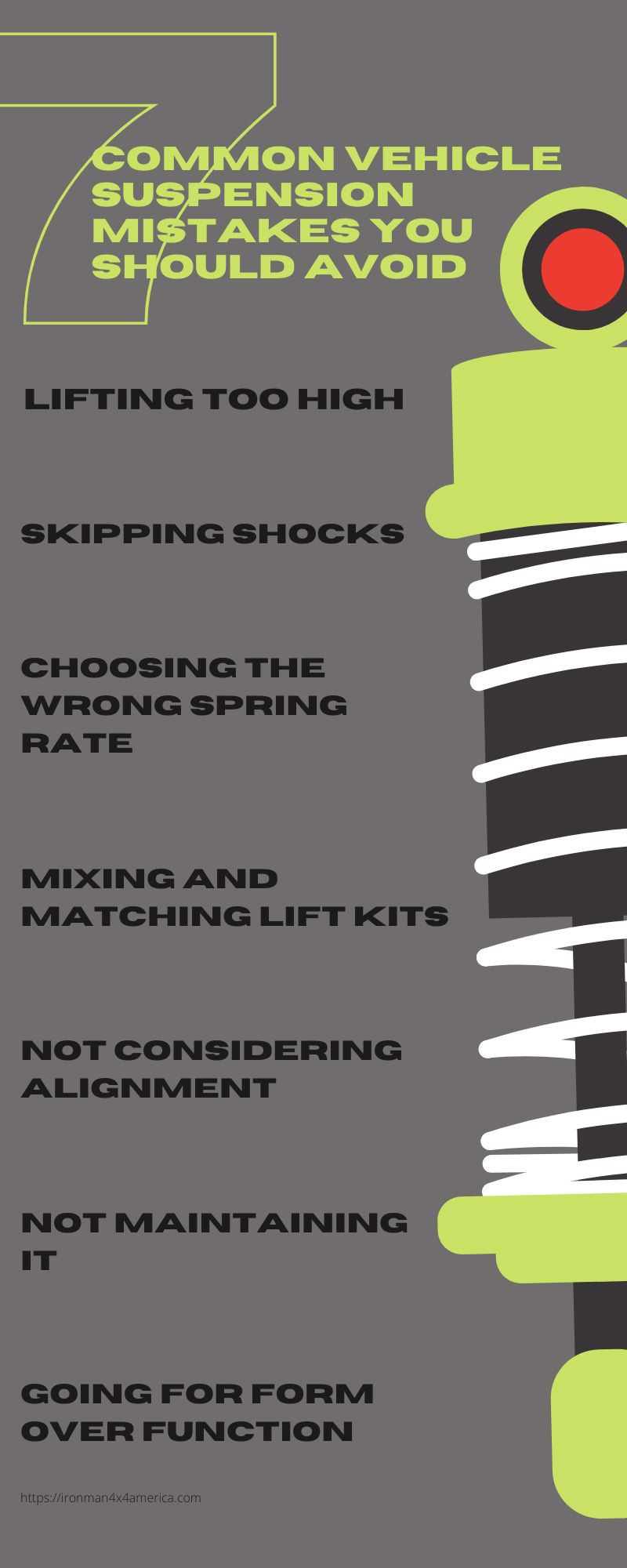7 Common Vehicle Suspension Mistakes You Should Avoid
Modifying your vehicle’s suspension is almost a rite of passage as an aspiring off-roader. But installing a suspension kit isn’t the simplest modification you can do to your vehicle, and the more complex the job, the more room there is for mistakes. Knowing the common suspension mistakes you should avoid going into the job will help you get the job done right.
Lifting Too High
If your goal is to crawl over rocks, your first instinct may be to go as high as possible to make it happen. But taller isn’t always better when it comes to lifting your 4x4. While there isn’t a single “correct” height for lifted suspensions, but you can keep these principles in mind when deciding:
- Limitations of your vehicle’s make and model
- Height laws in your state
- The type of off-roading you want to do
- Your visibility at that height
- Height of your desired tires
Also, keep in mind that the higher you lift your vehicle, the more the drivability is impacted. For instance, because the center of gravity is different in a lifted vehicle, it’s far easier to roll your vehicle. If you’re not experienced in driving lifted vehicles, consider not going as high with your first lift.
Skipping Shocks
Sure, you can lift a vehicle by adding spacers in the springs, or by simply replacing the coils. But upgrading your shocks is about more than keeping things comfortable for those in the cabin. With the kind of terrain you’re traveling over when you’re off-roading, your suspension takes a lot of abuse. This can send your whole system out of alignment, giving you a headache to deal with later.
If you’re planning on lifting your vehicle or even getting more aggressive tires, consider upgrading your shocks. Coilover shocks are often a popular choice for off-roaders because you can adjust the spring rate depending on the terrain you’ll be handling.
Choosing the Wrong Spring Rate
The only thing worse than not upgrading your springs at all is choosing the wrong ones. Choosing the right spring rate will depend on the type of terrain that you need your vehicle to handle and how much additional weight you’re carrying with gear and accessories.
Mixing and Matching Components
A lot has been said about using components of lift kits from multiple companies. Some do it for convenience, and some because they think they can get more height for their vehicle. However, it may cause you more problems than it solves.
The fact is that the components of a single kit are designed to work with the other parts in the kit. When you start swapping parts, you risk throwing off your driveshaft geometry, which can cause more damage to your suspension in the long run.
Not Completing an Alignment
Tire alignment is such a basic vehicle maintenance task that it sometimes goes under the radar, especially when you are doing more complex modifications. But any time you lift your vehicle, it will almost always throw off your tire’s alignment, so you will need to get an adjustment.
Even if you haven’t just lifted your suspension, it’s worth it to keep up-to-date on your yearly tire adjustments. Otherwise, your tires will meet the road at uneven angles, which can damage your suspension. Signs your tires may be out of alignment include:
- Off-center steering wheel
- Vehicle pulling off-center
- Tires are squealing
- Uneven tire tread wear
- Steering wheel vibrating
Not Maintaining It
You can put all the effort in the world into upgrading your suspension. However, if you continue to drive over rocky roads, sand dunes, and mud slicks and never maintain it, you are still going to end up in a bad place with your vehicle. A few essential maintenance tasks for your suspension include:
- Keep on top of changing your power steering fluid
- Service your joints regularly
- Rotate your tires every 3,000-5,000 miles
- Check your tire pressure
One of the best things you can do for your suspension is to simply pay attention to it. If you notice the suspension behaving strangely, don’t ignore it. Catching problems when they’re small will help avoid larger problems later on.
Going for Form Over Function
If we’re honest with ourselves, deep down, we know that at least part of the reason we want a lifted 4x4 is that it looks good. And there’s nothing wrong with that. However, you’re going to run into problems when you’ve put all your effort into purely aesthetic upgrades that simply lift your vehicle, yet you ignore practical improvements like upper control arms.
Improving your vehicle’s suspension is the key to a safe, comfortable off-roading experience. And if you want to take that essential first step into off-roading, Ironman 4x4 has the perfect off-road suspension parts for all your major suspension modifications.


